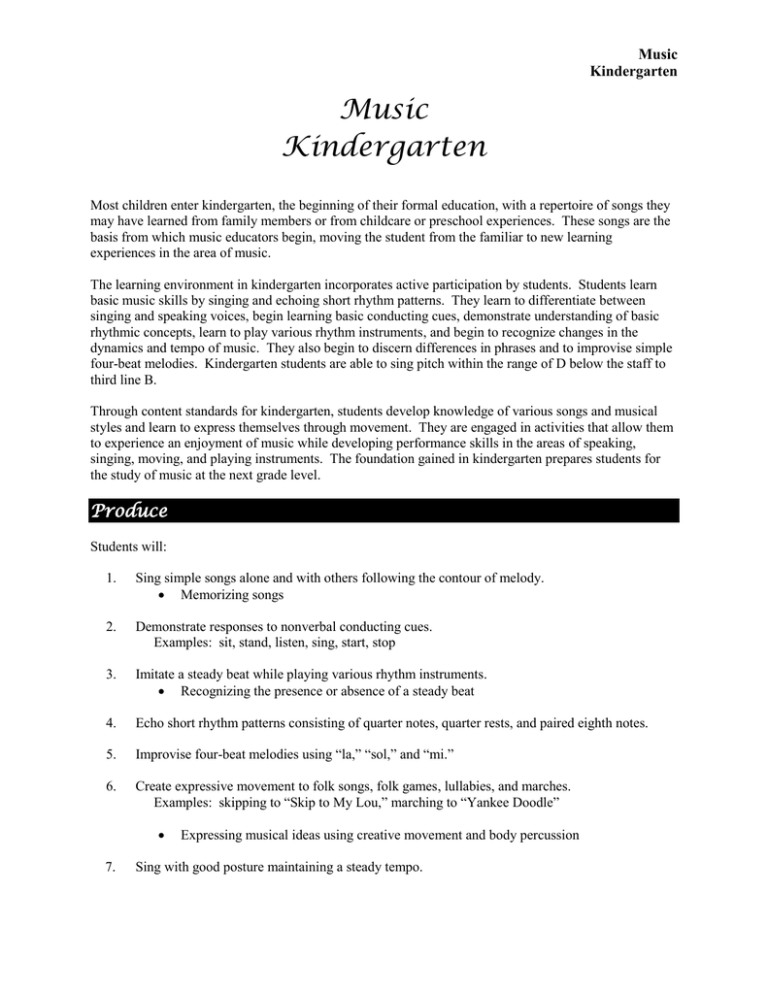Choral Music - Kindergarten
advertisement

Music Kindergarten Music Kindergarten Most children enter kindergarten, the beginning of their formal education, with a repertoire of songs they may have learned from family members or from childcare or preschool experiences. These songs are the basis from which music educators begin, moving the student from the familiar to new learning experiences in the area of music. The learning environment in kindergarten incorporates active participation by students. Students learn basic music skills by singing and echoing short rhythm patterns. They learn to differentiate between singing and speaking voices, begin learning basic conducting cues, demonstrate understanding of basic rhythmic concepts, learn to play various rhythm instruments, and begin to recognize changes in the dynamics and tempo of music. They also begin to discern differences in phrases and to improvise simple four-beat melodies. Kindergarten students are able to sing pitch within the range of D below the staff to third line B. Through content standards for kindergarten, students develop knowledge of various songs and musical styles and learn to express themselves through movement. They are engaged in activities that allow them to experience an enjoyment of music while developing performance skills in the areas of speaking, singing, moving, and playing instruments. The foundation gained in kindergarten prepares students for the study of music at the next grade level. Produce Students will: 1. Sing simple songs alone and with others following the contour of melody. Memorizing songs 2. Demonstrate responses to nonverbal conducting cues. Examples: sit, stand, listen, sing, start, stop 3. Imitate a steady beat while playing various rhythm instruments. Recognizing the presence or absence of a steady beat 4. Echo short rhythm patterns consisting of quarter notes, quarter rests, and paired eighth notes. 5. Improvise four-beat melodies using “la,” “sol,” and “mi.” 6. Create expressive movement to folk songs, folk games, lullabies, and marches. Examples: skipping to “Skip to My Lou,” marching to “Yankee Doodle” 7. Expressing musical ideas using creative movement and body percussion Sing with good posture maintaining a steady tempo. Music Kindergarten 8. Accompany melodies with simple rhythm patterns. Respond 9. Identify similarities and differences in familiar songs, including fast or slow and loud or soft. Example: comparing a march to a lullaby 10. Identify like and unlike phrases presented aurally in a piece of music. 11. Identify solo or group performances by sound. 12. Identify sets of two and three beats. 13. Recognize and practice accepted audience behavior. Understand 14. Recognize differences between adult and children’s voices. 15. Demonstrate singing and speaking voices. Example: singing and reciting the alphabet 16. Recognize holiday songs and simple songs from other cultures and countries. Examples: holiday—“Jingle Bells;” other cultures and countries—“Frère Jacques” 17. Identify various rhythm instruments by sight. 18. Differentiate high and low vocal sounds through vocal exploration. Example: producing aurally the sounds of a bird and a cow






